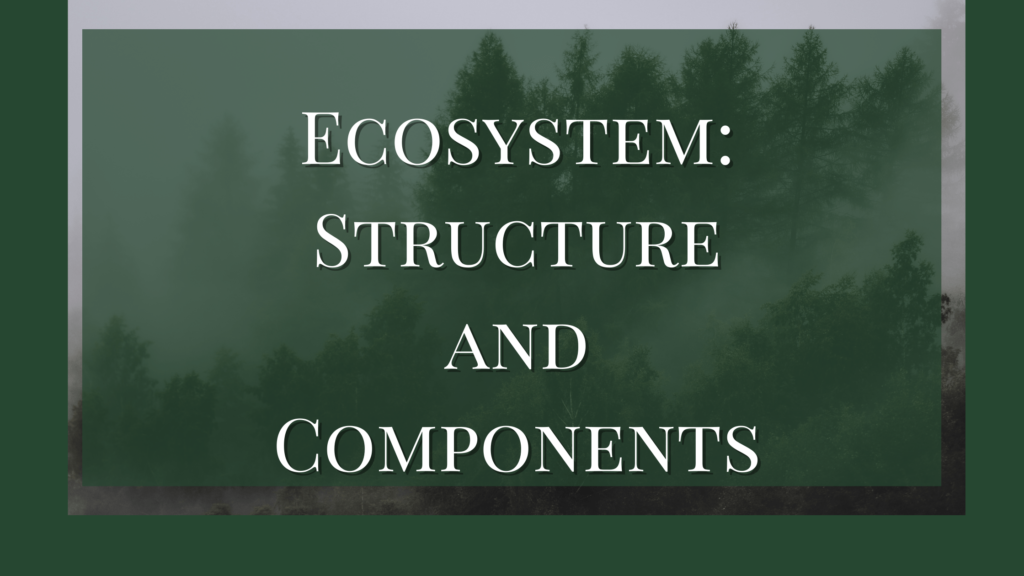The environment controls the development and distribution of organisms. Environment refers to the things and surroundings around the organisms that directly or indirectly influence the organism’s activities. Organisms interact with each other and also with physical conditions that are present in their habitat.
What is Ecosystem and Its Components
According to Clarke (1954), the organisms and physical features of a habitat form an ecological complex or ecosystem. Tanskey introduced the term ecosystem in 1935. It is the major ecological unit and has both structure and function that are related to the flow of energy and cycling of materials through structural components of the ecosystem.
Structural and Functional Components of Ecosystem
According to Odum (1971), the ecosystem is the basic functional unit interacting with each other and with all its components. There are two functional components as well.
- Autotrophic component which fixes light energy and manufactures food from inorganic materials. Eg, Green plants.
- Heterotrophic components that lack chlorophyll and obtain food energy directly or indirectly from autotrophs. Eg. Fungi, bacteria, animals, etc. They can decompose complex organic compounds into simple inorganic forms.
Odum identified two structural components.- abiotic and biotic.
Abiotic Components
Abiotic components are the non-living factors or the physio-chemical parts of an environment. It includes climatic factors such as rain, light, heat, energy from chemical bonds, temperature, precipitation, etc. The physio-chemical factors include gases such as oxygen, nitrogen, carbon dioxide, nutrients, and compounds like calcium, potassium, phosphorus, nitrates, water, etc.
Biotic Components
The biotic components include all living organisms such as autotrophs and heterotrophs. All green plants that perform photosynthesis are called autotrophs. Heterotrophs are living organisms that consume autotrophs and other heterotrophs. Thus biotic components can be classified into,
- Producers
- Consumers
- Decomposers
Producers
All green plants prepare food or carbohydrates through photosynthesis, with the help of simple inorganic substances like water, carbon dioxide, and elements in the presence of sunlight.
In this process, the energy from the sun is transferred into the potential energy of the organic food molecules such as carbohydrates, proteins, and fats. Oxygen is evolved as a byproduct, that is used for respiration by all living organisms.
Algae and other hydrophytes in a pond ecosystem, grass in a field, trees, etc are examples of producers. This category also includes photosynthetic bacteria. The latter obtains the energy needed to synthesize organic food from inorganic and organic substances.
The chemosynthetic bacteria which uses organic compounds to assimilate carbon dioxide is also part of the producers. So producers could be termed converters or transducers since they convert or transduce radiant energy into chemical energy.
Consumers
The living members of an ecosystem that consume the food synthesized by producers are called consumers. This category includes different kinds of animals that are found in the ecosystem. The different classes of consumers are,
- Consumers of the first order or primary consumers that are purely herbivorous, or eat only plants. They depend on plants or the producers for their food. Rabbits, deer, cows, goats, buffalo, etc are a few examples of primary consumers.
- Consumers of the second order or secondary consumers are carnivores and omnivores that feed on herbivorous animals and those who eat both plants and flesh, respectively.
- Consumers of the third order or tertiary consumers are top carnivores that feed on other carnivores, omnivores, and herbivores.
Parasites, scavengers and saprobes
These are a different class of consumers. Parasites depend on other organisms such as plants and animals for food and shelter. Scavengers and saprobes feed on dead remains of plants and animals.
Decomposers and Transformers
Bacteria and fungi are also part of the living components of an ecosystem. They form the growth of transformers and decomposers. Decomposers attack the dead remains of organic substances and break them down into simpler organic compounds.
Bacteria is an example of a transformer that transforms those simple organic compounds into inorganic components so that producers can easily take them to synthesize food. Decomposers and transformers are an integral part of an ecosystem that helps maintain its dynamic nature.
Detritivores
There is another kind called detrivores that consume organic matter from dead bodies and waste products from living organisms. They differ from decomposers. Detrivores consume the organic compounds using enzymes and absorb them as simpler compounds.
This type of nutrition is called coprophagy, involving the consumption of feces. Various flies, mites, and echinoderms like sea cucumber, etc are examples of detritivores. Since they consume the organic matter from producers and consumers of all trophic levels, they are part of each level of the trophic system and could be called secondary consumers.
The feeding strategy of detritivores breaks down larger compounds into smaller-sized ones. This increase in surface area can be used by bacteria to proceed with further decomposition process.
References
- Detritivore. (2019, March 27). Biology Dictionary. https://biologydictionary.net/detritivore/
- Shukla, R.S. and Chandel, P.S. (2001) Plant Ecology. S. Chand and Company Ltd., New Delhi.
- Verma, P.S., Agarwal, V.K. (1999). Cell Biology Genetics Molecular Biology Evolution and Ecology. New Delhi: S.Chand Co.(Pvt) Ltd.
Additional Reading




